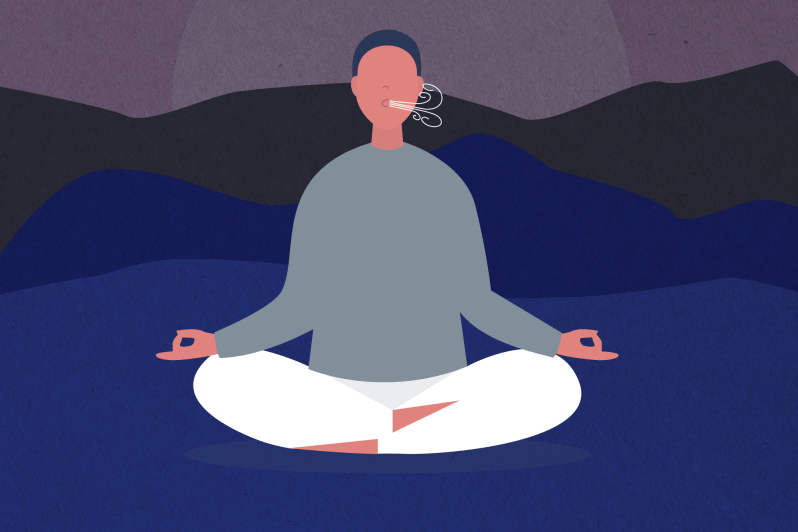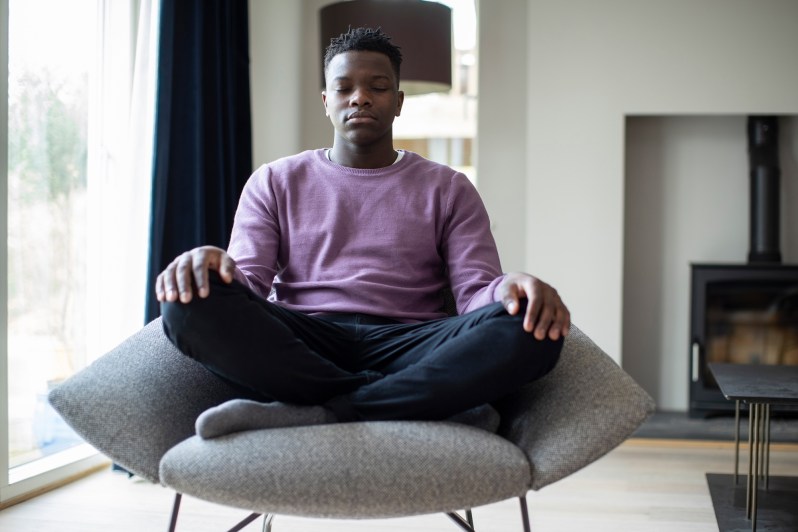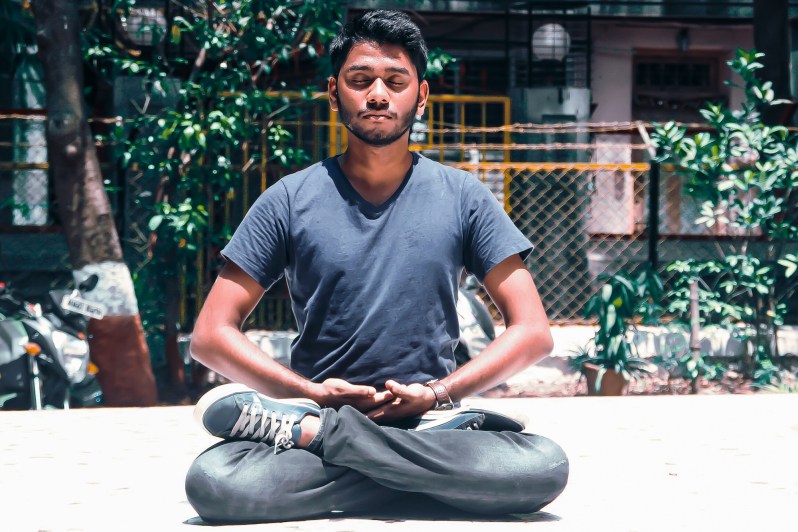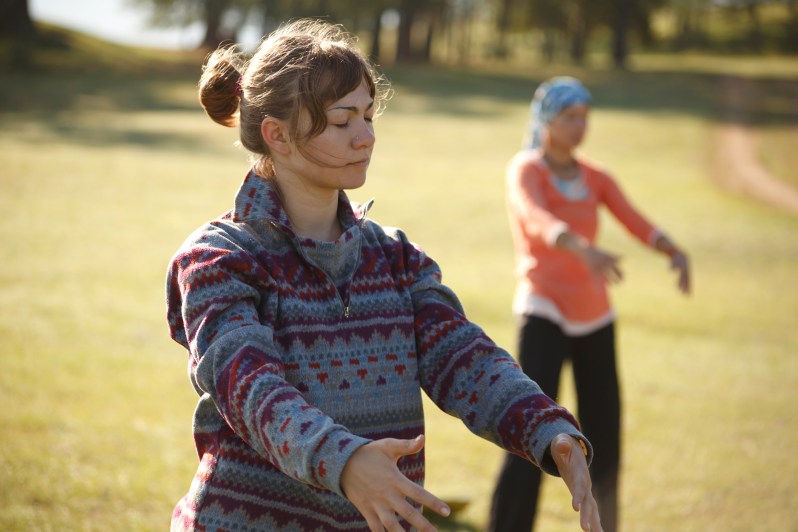At present time, learning to how to take care of oneself and meditate might be a great idea to consider. Sure, this may have been a New Year’s resolution that fell by the wayside, but with everything going on around us, not only do you probably have a lot more time on your hands, but you could also use the clarity that meditation can bring you.

Meditation came into the modern American consciousness in the 1890s, as a fringe thing for spiritual counterculture types, but in the late 1960s, it came under increasing study for its benefits to physical and mental health. Despite being in the mainstream for decades now, meditation still feels inaccessible for many. Maybe it’s because there are so many different varieties to try, or because the very idea of stillness and contemplation runs counter to everything American life is about.
But that break from the “always be hustling” mentality is what makes meditation so effective. If you have a job, a family, a schedule, or just a human body and mind, you can benefit from making meditation a regular part of your life.
What Is Meditation, Exactly?
For something that’s supposed to bring mental calm and clarity, learning how to meditate can involve a lot of confusion, contradiction, and even stress. The first obstacle is defining meditation. You might be aware that the end goal of meditation is to “empty your mind,” but what does that truly mean? It’s a difficult state to achieve when you can’t even really imagine what it feels like.
If you’ve tried to learn through doing, that presents just as many questions. You can read for hours about meditation from the world’s leading experts, and still not have a clear idea of what to do when you sit down to meditate. If you have a friend who meditates regularly, asking them how to start can lead you down a rabbit hole of contradictory advice, all while assuring you “there’s no ‘right’ way to meditate.” Not exactly helpful.
Let us help you clear it up.
Meditation Fundamentals
First, the fundamentals. All meditation styles and techniques are built around two main principles:
- Bringing the mind to a quiet, still state. This is known as “shamatha,” or cessation.
- Observing the workings of the mind in that state. This is known as “prajna,” or contemplation.

Techniques
Next, there are techniques that help cultivate these two principles. Different approaches to meditation will involve one or several additional elements, such as:
Mantra
“Mantra” is a Sanskrit word that can be translated as “a tool for freeing the mind.” Some mantras have a literal meaning, while others are meaningless sounds — they can be as short as one syllable or involve many words. On a basic level, the mantra functions as a “toy” to keep the brain occupied; on a higher level, the sounds within the mantra words carry a vibration that helps develop different states of mind. The words are meant to lose their meaning as you repeat them over and over, while still anchoring your mind within a state of open awareness.
Breathwork
Known in various cultures as pranayama, anapana, or qi-gong (to name just a few), specific breathing exercises can help deepen your meditation by creating a state of rhythmic calm that links your body and mind. Slow, regulated breathing helps open the channels of your life force or chi. Having these channels open is essential to fully experience the benefits of meditation.

Visualization
Some types of meditation involve focusing on a specific image, whether by actually looking at something (such as a flickering candle or a scene in nature) or just by using your imagination.
Finally, there are various schools and styles of meditation — hundreds of them, actually. Some are more formal and prescriptive, while others are quite loose and open to interpretation. This vast variety of options might be daunting, but the upside is that there’s a form to fit every lifestyle, personality, and schedule. We’ve put together a list of some of the most common ways to meditate, along with an overview of how to practice them and what issues they are particularly helpful for.
As you experiment, keep in mind that the end goal isn’t to become some sort of Jedi mind-trick master. (As if you need one more “mastery” goal on your list of to-do’s.) Rather, “success” in meditation is defined by a state of sustained mental rest. (Doesn’t that sound nice?) Trying super hard is counterproductive to the essence of meditation itself, so if you find yourself getting frustrated or struggling to grasp a technique, that probably means that you’re using a technique that isn’t a good fit for you.
We recommend choosing one to experiment with for a week or so, and seeing how it feels. Remember that meditation is an exercise, much like physical exercise, so if you’re going in cold, it’s good to start gently. Set yourself a goal that’s easy to achieve, like meditating once a day for just 5 to 10 minutes. You’ll know it’s the right approach for you if you find yourself wanting to spend more and more time with it. Once you discover an approach that you like, search for teachers, books, blogs, and other resources that will help you go deeper in that style. You may even be able to find a workshop or a retreat that offers more intensive guidance in reaping the benefits of your chosen meditation style.
Meditation Style
No matter which approach you choose, you’re guaranteed to benefit from a growing ability to detach from your thoughts, emotions, and cravings. This detachment doesn’t mean becoming emotionless — rather, it empowers you to choose which thoughts to heed and cultivate, giving you the freedom to experience life through a frame of clarity, peace, and even joy.
Mindfulness Meditation (also known as Vipassana Meditation)

This type of meditation incorporates more of the physical body as you train yourself to observe without judgment or reaction. To practice it, you sit upright but comfortably with your hands on your knees and your chin dropped slightly. After sitting this way for a few moments, you begin to concentrate on the feeling of breath filling your body and then leaving it. As thoughts and impulses arise, you acknowledge them and let them drift away, returning to the focus on your breath. The payoff is an increasing ability to return to your focus without emotion or self-judgment. When you’ve finished, slowly lift your gaze forward, take note of how your body feels, and then move on with your day.
Best for: Improving attention, making progress toward goals, managing stress, and chronic pain
Guided Meditation (usually includes affirmations and body scan)
This type of meditation combines a number of different techniques such as breathwork, visualization, and mantra. It’s one of the most accessible approaches available — you can practice with a coach, use a recording, or practice with your own mantra while listening to calming music or nature sounds. There are even a number of guided meditation options on YouTube.
Best for: Reducing irrational or negative thinking, raising levels of optimism, developing coping skills
Transcendental Meditation
Known popularly as “TM,” this is the model people usually think of when they think meditation — sitting on the floor cross-legged, eyes closed while chanting a secret mantra for 20 minutes or more. Developed by Maharishi Mahesh Yogi in the 1950s, this form of meditation has been trademarked (cue joke about “TM-TM”) and corporatized to some degree, with celebrities like Jerry Seinfeld and Hugh Jackman paying thousands of dollars for a licensed guru to give them their own secret mantra. However, you can access the benefits for free, if you’re not afraid of some rigorous self-discipline. Unlike other types of meditation, TM mantras are meaningless words meant to help the mind disconnect from conscious thought. As you continue the mantra, the mind will gradually drift above distractions and emotions and reach a state of restful awareness. This is the coveted feeling that TM devotees say changes their lives, and the more often you practice, the easier it is to achieve.
Best for: Improving calmness, better sleep, lower blood pressure, improved cognitive function and memory
Zen or Zazen Meditation

Zazen literally means “seated,” and that pretty much sums up what this meditation style is about: learning to sit. It’s harder than it sounds — the end goal is to be able to exist indefinitely in a state of suspended judgment, letting all words, thoughts, and images pass by without getting involved in them. To practice, you sit in a lotus position or by kneeling, your hands folded over your belly, and your spine straight but settled. With eyelids half-closed (to present yourself as neutral toward external stimuli), begin to focus on your breath’s movement in and out of your body. You can count the beats within each breath, use a mantra to measure it, or just observe it. The goal is to arrive at a state of calm, thoughtless focus. However, over time, you’ll begin reaching an even higher state of calm clarity where you can actually think about not thinking.
Best for: Lowering blood pressure, reducing anxiety and stress, strengthening immune systems, improving sleep
Kundalini Meditation
Developed by Yogi Bhajan a year before the Summer of Love, kundalini meditation is meant to develop a conscious connection with the energy inside you. This type of meditation has a few more rules than most — practitioners do it either first thing in the morning or right before bed, but never on a full stomach, and it requires choosing how long to meditate before you start. (For some reason, common intervals are 11 minutes, 15 minutes, 22 minutes, 31 minutes.) You pick a mantra that expresses the state you want to achieve, then begin to either chant it out loud or silently in your head while visualizing the mantra being written down. While chanting, slow your breathing down so that each completed breath lasts about 8 seconds. As the breathing lengthens and the mantra becomes automatic, focus on the movement of breath through your body. Eventually, you’ll start to feel the energy moving along your spine and a euphoric state brewing inside you. The combination of mantra, breathing, and consciousness helps cleanse your mind, making you less reactive to stress and offering a powerful rejuvenation at the end of the day.
Best for: Improving concentration and cognitive function, stress relief, strengthening the nervous system
Metta Meditation (also known as “loving-kindness meditation” or “compassion-based meditation”)
This form is named for one of the four sublime states in a particular school of Buddhism. It involves silently repeating phrases of goodwill directed toward someone else, visualizing them if you like. The word “metta” can be translated as loving-kindness or as compassion, and there are two schools of thought around how this type of meditation is practiced: You can either repeat phrases of hope for another person’s relief from suffering or for them to experience happiness. No matter which approach you take, the idea behind metta meditation is that cultivating kindness toward all beings (including yourself) gradually decreases the tendency to cling to a negative state of mind. A side benefit of metta meditation is that it’s said to be effective more quickly than other types of meditation — a study by Psychology Today showed that just a few minutes of metta meditation increased people’s feelings of social connection and positivity toward strangers.
Best for: Building empathy, decreasing bias, improving social connection, lowering stress response to conflict.
Tibetan Sky Gazing

This is a great form of meditation for nature lovers. Guided by the idea that the mind is clear like water, and whatever you focus on colors that clear awareness, this type of meditation endeavors to influence the mind with nature’s beauty and serenity. By gazing into the sky, you can experience openness, clarity, and enlightenment. Start by finding a good view of the clear sky — you can climb to a high place or even lie on your back. Calm your mind with a series of long, deep, slow breaths, then gradually draw your gaze upward until you’re looking directly into the sky. Let go of all thoughts as you direct your awareness into the vast blue expanse, appreciating how your inner thoughts evaporate into your inner sky the way clouds do. When you’re ready to end your meditation, acknowledge that this expansive experience is, in fact, the most natural state of your being.
Best for: Relieving stress, connecting with nature, improving your perspective
Tantric Meditation
The word “Tantric” is irrevocably associated with sex, but more holistically, Tantric practices involve using energy to create some sort of transformation. Unlike meditation styles that are meant to empty our minds of thoughts, Tantric meditation uses sounds, colors, mantras, vibrations, visualizations, and more to cultivate a specific resonance within the body that produces specific results and eventually leads to enlightenment. There are a number of different ways to practice, but an easy one to start with is visualizing each section of your body filling up with golden light, until your entire body is a glowing column of light, then finishing by exhaling all the light into the world around you.
Best for: Emotional balance, enhanced memory, concentration, and focus, a more vibrant sense of health
Qi Gong

If you’re an ants-in-the-pants type of guy, qi gong might be the perfect meditation style for you. This practice combines breath, body movement, and mental concentration to unblock energy channels in your body so that your life force can move freely. It can be practiced while standing, sitting, or even lying down. You might be familiar with tai chi, the body movement technique that looks like martial arts in slow motion, which is commonly linked with qi gong. However, tai chi is just one of a number of repetitive movement “recipes” for qi gong. These movement styles range from beginner to advanced, so it’s helpful to begin by following a video tutorial or attending a workshop to find the best entry point for you.
Best for: Improving balance, lowering blood pressure, healing chronic health conditions, achieving clarity of purpose
Taoist Emptiness Meditation
This type of meditation is just what it sounds like: emptying the mind of all mental images (thoughts, feelings, and so on) in order to experience a state of inner quiet. One of three styles of qi gong meditation, it starts with sitting in a comfortable upright position, with eyes half-closed and fixed on the point of the eyebrows. As you sit quietly, you allow all thoughts and sensations to arise and fall without engaging with them. While this style of meditation is said to be very challenging, the work (rather than the destination) is the point. The more your practice, the more you’ll sense your life force being replenished.
Best for: Longevity, unifying body, and spirit, connecting with nature, finding inner peace
Sufi Meditation
Known as muraqabah in Arabic, this type of meditation comes from Islamic tradition. Its objective is to purge the selfish, more animalistic parts of your character and replace them with more noble, generous character traits. The practice of Sufi meditation starts with cultivating a state of half-wakeful calmness, but with more practice, you reach a state where you can receive spiritual messages within the subconscious mind, see visions, and access knowledge. There’s a wide variety of ways to practice Sufi meditation, from breathing exercises to gazing practices, vocalization, and even whirling.
Best for: Releasing serotonin and endorphins, releasing stress, gaining perspective, cultivating positivity


